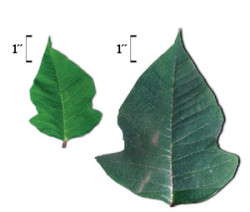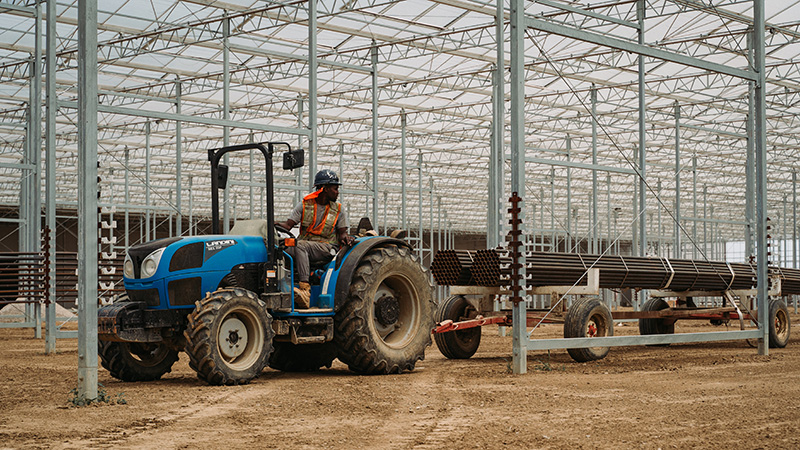Cold Finishing Up North

Over the past several years, greenhouse growers have experienced a roller coaster ride with energy costs for heating and transportation. In recent months, natural gas prices have decreased nationally by 31 percent from last summer’s highs. Economists, however, predict prices will rise again in the near future. Therefore, it is never too early to start thinking about how you can reduce your energy consumption in the greenhouse.
Cultivar Selection
For greenhouse operations in northern latitudes, energy costs for heating alone account for 10 to 30 percent of their total operating cost. Poinsettia cold finishing is a viable option that growers can use to help reduce both energy and input costs. However, it is important to remember not all cultivars can be cold finished successfully.
Cultivars that are good candidates for cold finishing are those that are marketable early in the season (six- to eight-week response time), moderate vigor and have naturally large bracts. Why? Poinsettias finished at cooler temperatures can be shorter, have smaller bracts and be delayed (timing) compared to those finished at warmer temperatures.
For our study, we worked with the five major poinsettia breeders: Ecke Ranch, Dömmen, Florema Young Plants, Selecta First Class and Syngenta Flowers to study two red poinsettia cultivars from each of their genetics.
Cold Finishing
Research was conducted at Purdue University in West Lafayette, Ind. (latitude 40°N) and the University of New Hampshire in Durham, N.H. (latitude 43°N) to study the effects of cold finishing under a range of temperatures on ‘Advent Red,’ ‘Prestige Early Red,’ ‘EarlyGlory Red,’ ‘Viking Red,’ ‘Christmas Eve,’ ‘Christmas Feelings,’ ‘Early Orion,’ ‘Orion,’ ‘Alreddy Red’ and ‘Saturnus Red.’
Rooted cuttings were received during the week of July 28, August 4, August 11 and August 18 (Week 31-34), transplanted into 6.5-inch pots and grown at day/night temperatures of 75/67°F and a 16-hour photoperiod provided by high-pressure sodium lamps, until the start of short days on October 1.
One goal of this research was to quantify how constant and fluctuating cold finishing temperatures with the same average daily temperature affect poinsettia growth and development. On October 15, plants were transferred to cold finishing temperatures. We chose to begin cold finishing two weeks after the start of short days when average outdoor night temperatures are below 45°F across much of the northern United States, leading to significant energy savings.
Height
Until the start of cold finishing, the height of all the cultivars was above our target heights because we did not use plant growth regulators (PGRs). Allowing the plants to grow above the target height before cold finishing compensated for the reduced stem elongation that occurred during the cold finish period.
The final heights of all 10 moderate vigor cultivars planted on Week 33 in our study were within or near the 14- to 16-inch range. As would be expected, final heights of all the poinsettia cultivars planted on weeks 31 or 32 were significantly greater than those planted on week 33.
Bract Expansion Over Time
In order to determine if cold finishing temperatures influence the expansion of poinsettia leaves and ultimately bracts, we began taking digital photographs of leaves of one cultivar in each of the six cold finish temperature treatments on October 15. Figure 2 (on page 88) provides an example of the size of leaves that we began measuring.
Graphical tracking of 10 poinsettia cultivars that were planted on August 13 (Week 33) and cold finished at 68/ 56°F day/night (average daily temperature of 62 °F).
Using computer software, we were then able to non-destructively determine the leaf area of the photographed leaf. Photographs of the same leaves were subsequently taken each week to track leaf expansion over time until November 26. In Figure 3 (page 88), we can see how much the leaf in Figure 2 expanded after six weeks at 68/56°F. The average leaf area at the different constant and fluctuating temperatures is presented in Figure 4.
With the exception of the coldest treatment of 61/55°F, leaf area after six weeks was between 14.4 and 15.5 square inches across the cold finishing temperatures. This indicates individual leaf or bract expansion was not delayed by constant or fluctuation cold finish temperatures at or above 62°F.
Visible Bract Area
At anthesis (first pollen shed), bract length and width of the top four bracts (widest diameter across and widest diameter 90 degrees across) on a stem was measured and visible bract area per stem was determined by using the formula for an ellipse.
Our results and those of Jim Faust and colleagues at Clemson University indicate bract area per stem was commercially acceptable with an ADT at or above 60°F across several cultivars tested. However, bract area was reduced and unacceptable when poinsettias were cold finished at ADT below 60°F.
Timing
One of the most important factors that can limit cold finishing is the delay in timing that can occur from reduced temperatures. In our study, time to anthesis from the start of short days was delayed by two to 21 days for all cultivars that were cold finished at constant and fluctuating ADT of 62 and 66°F, compared to the 75/67°F (ADT of 71°F) treatment. Therefore, early-season cultivars with a six- to eight-week response time should finish and be marketable between mid- to late-November. It is also important to note that plants can be marketable a few days to two weeks before anthesis depending on the cultivar.
Temperatures
The cold-finishing temperatures in our trial represent a wide range of temperatures attainable by northern greenhouse growers. When an ADT of 62 or 66°F was obtained by holding a constant temperature throughout the day and night, plants were not as visually appealing as plants grown at the same ADT but with fluctuating day/night temperatures.
Generally, plant height was relatively similar regardless of how the ADT was obtained. Average daily temperature did, however, affect timing, plant diameter, visible bract area per stem and bract expansion. Plants finished at 61/55°F were significantly smaller in all of these parameters and not marketable. Plants finished at 75/67°F were larger but to the extent that they may be relatively more difficult to ship, a PGR application may be needed.
Additional Benefits
Other reported benefits to this production scheme include reduced or no PGR use, an increased post-harvest life of plants and intense and brighter bract colors.
All the red cultivars we tested in our trial were successfully cold finished at 68/56ºF and 70/62ºF without excessive delays in timing or negative effects on height or bract area. Keep in mind the base temperature or the temperature at which the developmental rate is zero is 50°F for poinsettias. Therefore, night temperatures should never drop below 55°F to obtain a desired ADT. Likewise, excessively high temperatures during the day can also cause problems.









